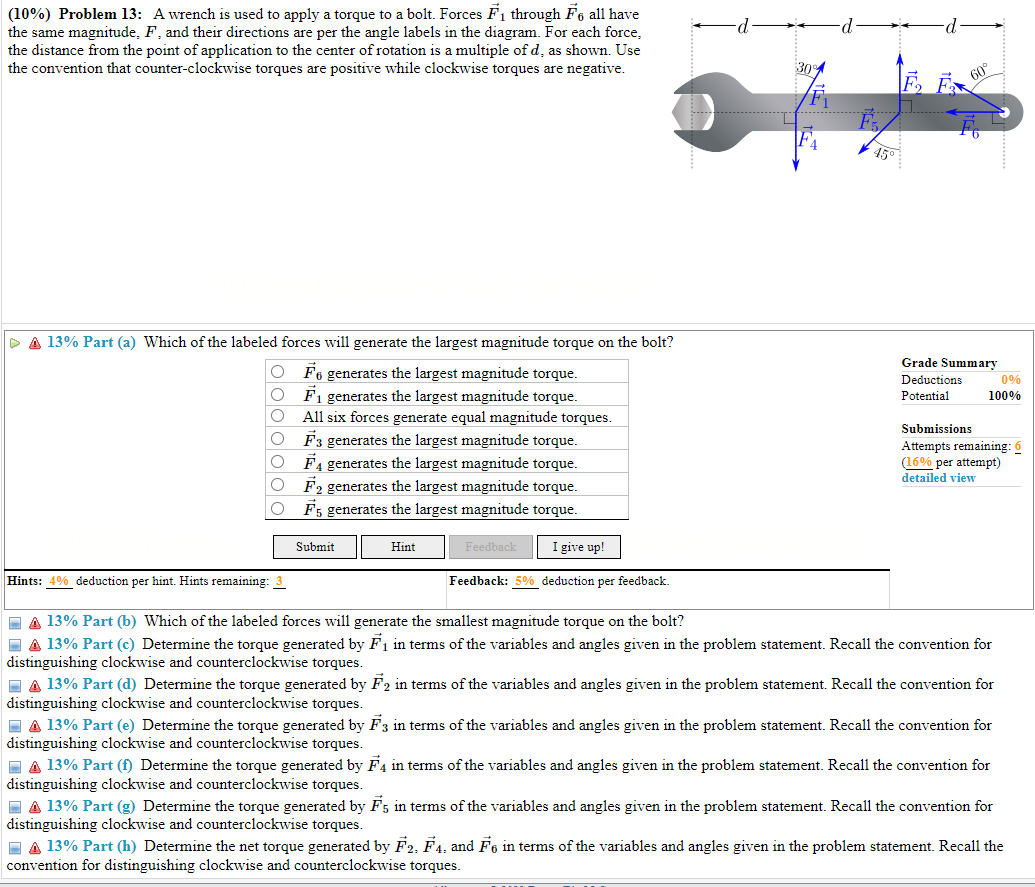Home /
Expert Answers /
Advanced Physics /
10-problem-13-a-wrench-is-used-to-apply-a-torque-to-a-bolt-forces-v-pa187
(Solved): (10\%) Problem 13: A wrench is used to apply a torque to a bolt. Forces \( \v ...

(10\%) Problem 13: A wrench is used to apply a torque to a bolt. Forces \( \vec{F}_{1} \) through \( \vec{F}_{6} \) all have the same magnitude, \( F \), and their directions are per the angle labels in the diagram. For each force, the distance from the point of application to the center of rotation is a multiple of \( d \), as shown. Use the convention that counter-clockwise torques are positive while clockwise torques are negative. \( \triangleright 13 \% \) Part (a) Which of the labeled forces will generate the largest magnitude torque on the bolt? \begin{tabular}{|lll} \hline Hints: deduction per hint. Hints remaining: & Feedback: deduction per feedback. \end{tabular} ? 13\% Part (b) Which of the labeled forces will generate the smallest magnitude torque on the bolt? ) Determine the torque generated by \( \vec{F}_{1} \) in terms of the variables and angles given in the problem statement. Recall the convention for distinguishing clockwise and counterclockwise torques. @ 13\% Part (d) Determine the torque generated by \( \vec{F}_{2} \) in terms of the variables and angles given in the problem statement. Recall the convention for distinguishing clockwise and counterclockwise torques. @ 13\% Part (e) Determine the torque generated by \( \vec{F}_{3} \) in terms of the variables and angles given in the problem statement. Recall the convention for distinguishing clockwise and counterclockwise torques. @ \( 13 \% \) Part (f) Determine the torque generated by \( \vec{F}_{4} \) in terms of the variables and angles given in the problem statement. Recall the convention for distinguishing clockwise and counterclockwise torques. @ 13\% Part (g) Determine the torque generated by \( \vec{F}_{5} \) in terms of the variables and angles given in the problem statement. Recall the convention for distinguishing clockwise and counterclockwise torques. \( \triangle 13 \% \) Part (h) Determine the net torque generated by \( \vec{F}_{2}, \vec{F}_{4} \), and \( \vec{F}_{6} \) in terms of the variables and angles given in the problem statement. Recall the convention for distinguishing clockwise and counterclockwise torques.
Expert Answer
Torque is defined as the product of the applied force and the perpendicular distance of the force from the point of rotation. ?=Frsin??